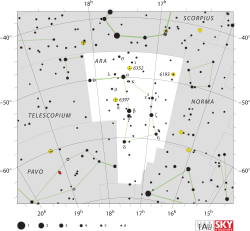Zeta Arae

| |
| Observation data Epoch J2000 Equinox J2000 | |
|---|---|
| Constellation | Ara |
| Right ascension | 16h 58m 37.21217s[1] |
| Declination | –55° 59′ 24.5203″[1] |
| Apparent magnitude (V) | 3.13[2] |
| Characteristics | |
| Spectral type | K3 III[3] |
| U−B color index | +1.96[2] |
| B−V color index | +1.60[2] |
| Astrometry | |
| Radial velocity (Rv) | –6.0[4] km/s |
| Proper motion (μ) | RA: –17.80[1] mas/yr Dec.: –36.67[1] mas/yr |
| Parallax (π) | 6.71 ± 0.19[1] mas |
| Distance | 490 ± 10 ly (149 ± 4 pc) |
| Absolute magnitude (MV) | –3.95[5] |
| Details | |
| Mass | 7-8[6] M☉ |
| Radius | 114[6] R☉ |
| Luminosity | 3,800[6] L☉ |
| Surface gravity (log g) | 1.20[6] cgs |
| Temperature | 4,246[6] K |
| Metallicity [Fe/H] | –0.40[7] dex |
| Other designations | |
| Database references | |
| SIMBAD | data |
| Data sources: | |
| Hipparcos Catalogue, CCDM (2002), Bright Star Catalogue (5th rev. ed.) | |
Zeta Arae (ζ Ara, ζ Arae) is a star in the southern constellation Ara. It is sometimes is called by the name Tseen Yin, together with δ Arae.[9] The apparent visual magnitude of this star is 3.1,[2] which can be seen from suburban skies in the southern hemisphere. From the parallax measurements, it is located at a distance of 490 light-years (150 parsecs) from Earth.[1]
The spectrum of this star matches a stellar classification of K3 III.[3] The luminosity class of 'III' indicates this is a giant star that has exhausted the hydrogen at its core and evolved away from the main sequence. It is radiating energy from its outer atmosphere at an effective temperature of 4,246 K which is what gives it the orange hue of a K-type star.[10] This star displays an excess of infrared emission that may indicate circumstellar matter.[11]
In Chinese, 杵 (Guī), meaning Tortoise, refers to an asterism consisting of ζ Arae, ε1 Arae, γ Arae, δ Arae and η Arae.[12] Consequently, ζ Arae itself is known as 龜五 (Guī wǔ, English: the Fifth Star of Tortoise.)[13]
References
- 1 2 3 4 5 6 van Leeuwen, F. (November 2007), "Validation of the new Hipparcos reduction", Astronomy and Astrophysics, 474 (2): 653–664, arXiv:0708.1752
 , Bibcode:2007A&A...474..653V, doi:10.1051/0004-6361:20078357
, Bibcode:2007A&A...474..653V, doi:10.1051/0004-6361:20078357 - 1 2 3 4 Johnson, H. L.; et al. (1966), "UBVRIJKL photometry of the bright stars", Communications of the Lunar and Planetary Laboratory, 4 (99): 99, Bibcode:1966CoLPL...4...99J
- 1 2 Houk, Nancy (1978), "Michigan catalogue of two-dimensional spectral types for the HD stars", University of Michigan Catalogue of two-dimensional spectral types for the HD stars. Volume I. Declinations -90_ to -53_ƒ0, Ann Arbor: Dept. of Astronomy, University of Michigan, 1, Bibcode:1975mcts.book.....H
- ↑ Wielen, R.; et al. (1999), "Sixth Catalogue of Fundamental Stars (FK6). Part I. Basic fundamental stars with direct solutions", Veröff. Astron. Rechen-Inst. Heidelb, Astronomisches Rechen-Institut Heidelberg, 35 (35), Bibcode:1999VeARI..35....1W
- ↑ Jasniewicz, G.; et al. (February 1999), "Late-type giants with infrared excess. I. Lithium abundances", Astronomy and Astrophysics, 342: 831–838, Bibcode:1999A&A...342..831J
- 1 2 3 4 5 Cruzalèbes, P.; Jorissen, A.; Rabbia, Y.; Sacuto, S.; Chiavassa, A.; Pasquato, E.; Plez, B.; Eriksson, K.; Spang, A.; Chesneau, O. (2013). "Fundamental parameters of 16 late-type stars derived from their angular diameter measured with VLTI/AMBER". Monthly Notices of the Royal Astronomical Society. 434: 437. arXiv:1306.3288
 . Bibcode:2013MNRAS.434..437C. doi:10.1093/mnras/stt1037.
. Bibcode:2013MNRAS.434..437C. doi:10.1093/mnras/stt1037. - ↑ Jones, K. L.; et al. (June 1992), "Spectroscopic investigation of cool giants and the authenticity of their reported microwave emission", Monthly Notices of the Royal Astronomical Society, 256 (3): 535–544, Bibcode:1992MNRAS.256..535J, doi:10.1093/mnras/256.3.535
- ↑ "zet Ara -- Star", SIMBAD, Centre de Données astronomiques de Strasbourg, retrieved 2012-01-05
- ↑ Allen, R. H. (1963). Star Names: Their Lore and Meaning (Reprint ed.). New York, NY: Dover Publications Inc. p. 64. ISBN 0-486-21079-0.
- ↑ "The Colour of Stars", Australia Telescope, Outreach and Education, Commonwealth Scientific and Industrial Research Organisation, December 21, 2004, retrieved 2012-01-16
- ↑ Plets, H.; et al. (July 1997), "Giants with infrared excess", Astronomy and Astrophysics, 323: 513–523, Bibcode:1997A&A...323..513P
- ↑ (Chinese) 中國星座神話, written by 陳久金. Published by 台灣書房出版有限公司, 2005, ISBN 978-986-7332-25-7.
- ↑ (Chinese) AEEA (Activities of Exhibition and Education in Astronomy) 天文教育資訊網 2006 年 7 月 1 日